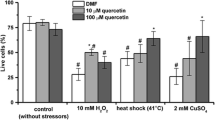Abstract
The inhibitor of catalase 3-amino-1,2,4-triazole (AMT) was used to study the physiological role of catalase in the yeast Saccharomyces cerevisiae under starvation. It was shown that AMT at the concentration of 10 mM did not affect the growth of the yeast. In vivo and in vitro the degree of catalase inhibition by AMT was concentration- and time-dependent. Peroxisomal catalase in bakers’ yeast was more sensitive to AMT than the cytosolic one. In vivo inhibition of catalase by AMT in S. cerevisiae caused a simultaneous decrease in glucose-6-phosphate dehydrogenase activity and an increase in glutathione reductase activity. At the same time, the level of protein carbonyls, a marker of oxidative modification, was not affected. Possible mechanisms compensating the negative effects caused by AMT inhibition of catalase are discussed.
Similar content being viewed by others

Abbreviations
- AMT:
-
3-amino-1,2,4-triazole
- CP:
-
protein carbonyls
- G6PDH:
-
glucose-6-phosphate dehydrogenase
- GR:
-
glutathione reductase
- ICDH:
-
isocitrate dehydrogenase
- LDH:
-
lactate dehydrogenase
- PMSF:
-
phenylmethylsulfonyl fluoride
- ROS:
-
reactive oxygen species
- SOD:
-
superoxide dismutase
- TEMED:
-
N,N,N′,N′-tetramethylethylenediamine
References
Bartosz, G. (2004) The Second Face of Oxygen. Free Radicals in Nature [in Polish], Wydawnictwo Naukowe PWN, Warsaw.
Ruis, H., and Koller, F. (1997) in Oxidative Stress and the Molecular Biology of Antioxidant Defenses (Scandalios, J. G., ed.) Cold Spring Harbor, Cold Spring Harbor Laboratory Press, N. Y., pp. 273–308.
Lushchak, O., Bagnyukova, T., and Lushchak, V. (2003) Ukr. Biochem. J., 75, 45–50.
Lushchak, V., Semchyshyn, H., Mandryk, S., and Lushchak, O. (2005) Arch. Biochem. Biophys., 441, 35–40.
Bagnyukova, T. V., Storey, K. B., and Lushchak, V. I. (2005) Comp. Biochem. Physiol., B142, 335–341.
Bayliak, M., Semchyshyn, H., and Lushchak, V. (2006) Biochemistry (Moscow), 71, 1013–1020.
Semchyshyn, H., Dylyovyj, M., and Lushchak, V. (2002) Ukr. Biochem. J., 74, 34–41.
Lushchak, V. I., and Gospodaryov, D. V. (2005) Cell Biol. Int., 29, 187–192.
Lushchak, V., Semchyshyn, H., Lushchak, O., and Mandryk, S. (2005) Biochem. Biophys. Res. Commun., 338, 1739–1744.
Putnam, C. D., Arvai, A. S., Bourne, Y., and Tainer, J. A. (2000) J. Mol. Biol., 296, 295–309.
Tripathi, G., Wiltshire, C., Macaskill, S., Tournu, H., Budge, S., and Brown, A. J. P. (2002) EMBO J., 21, 5448–5456.
Lushchak, V. I. (1998) Biochem. Mol. Biol. Int., 44, 425–431.
Bradford, M. M. (1976) Analyt. Biochem., 72, 248–254.
Costa, V., and Moradas-Ferreira, P. (2001) Molec. Aspects Med., 22, 217–246.
Izawa, S., Inoue, Y., and Kimura, A. (1996) Biochem. J., 320, 61–67.
Kowaltowski, A. J., Vercesi, A. E., Rhee, S. G., and Netto, L. E. (2000) FEBS Lett., 437, 177–182.
Ueda, M., Kinoshita, H., Yoshida, H., Kamasawa, N., Osumi, M., and Tanaka, A. (2003) FEMS Microbiol. Lett., 219, 93–98.
Barja de Quiroga, G., Lopez-Torres, M., and Perez-Campo, R. (1989) Comp. Biochem. Physiol., C94, 391–398.
Perez-Campo, R., Lopez-Torres, M., Rojas, C., Cadenas, S., and Barja de Quiroga, G. (1993) Mechanisms Ageing Devel., 67, 115–127.
Bagnyukova, T. V., Vasylkiv, O. Yu., Storey, K. B., and Lushchak, V. I. (2005) Brain Res., 1052, 180–186.
Hawkes, T. R., Thomas, P. G., Edwards, L. S., Rayner, S. J., and Wilkinson, K. W. (1995) Biochem. J., 306, 385–397.
Benjamin, P. M., Wu, J. I., Mitchell, A. P., and Magasanik, B. (1989) Mol. Gen. Genet., 217, 370–377.
Kanazawa, S., Driscoll, M., and Struhl, K. (1988) Mol. Cell Biol., 8, 664–673.
Natarajan, K., Meyer, M. R., Jackson, B. M., Slade, D., Roberts, C., Hinnebusch, A. G., and Marton, M. J. (2001) Mol. Cell. Biol., 21, 4347–4368.
Yin, Z., Stead, D., Selway, L., Walker, J., Riba-Garcia, I., Mclnerney, T., Gaskell, S., Oliver, S. G., Cash, P., and Brown, A. J. P. (2004) Proteomics, 4, 2425–2436.
Anderson, R. M., Latorre-Esteves, M., Neves, A. R., Lavu S., Medvedik, O., Taylor, C., Howitz, K. T., Santos, H., and Sinclair, D. A. (2003) Science, 302, 2124–2126.
Sinclair, D., Mills, K., and Guarente, L. (1998) Annu. Rev. Microbiol., 52, 533–560.
Fabrizio, P., Gattazzo, C., Battistella, L., Wei, M., Cheng, C., McGrew, K., and Longo, V. D. (2000) Cell, 123, 655–667.
Madeo, F., Herker, E., Wissing, S., Jungwirth, H., Eisenberg, T., and Frohlich, K. U. (2004) Curr. Opin. Microbiol., 7, 655–660.
Demple, B. (1991) Annu. Rev. Genet., 25, 315–337.
Gospodaryov, D., Bayliak, M., and Lushchak, V. (2005) Ukr. Biochem. J., 77, 54–60.
Author information
Authors and Affiliations
Corresponding author
Additional information
Published in Russian in Biokhimiya, 2008, Vol. 73, No. 4, pp. 515–523.
Originally published in Biochemistry (Moscow) On-Line Papers in Press, as Manuscript BM07-269, February 24, 2008.
Rights and permissions
About this article
Cite this article
Bayliak, M., Gospodaryov, D., Semchyshyn, H. et al. Inhibition of catalase by aminotriazole in vivo results in reduction of glucose-6-phosphate dehydrogenase activity in Saccharomyces cerevisiae cells. Biochemistry Moscow 73, 420–426 (2008). https://doi.org/10.1134/S0006297908040068
Received:
Revised:
Published:
Issue Date:
DOI: https://doi.org/10.1134/S0006297908040068



